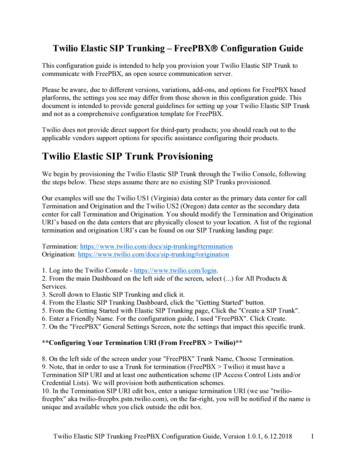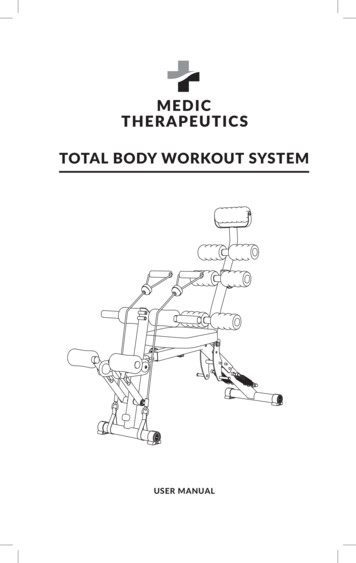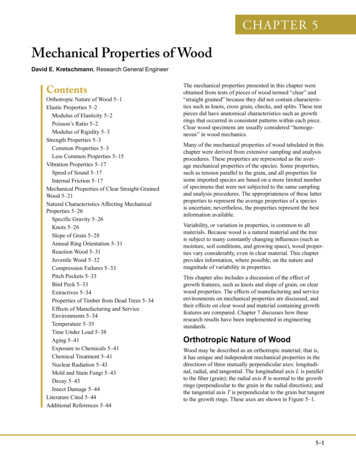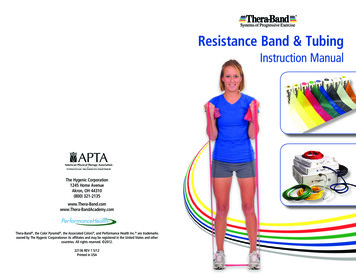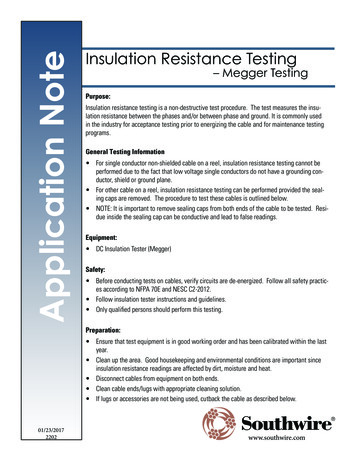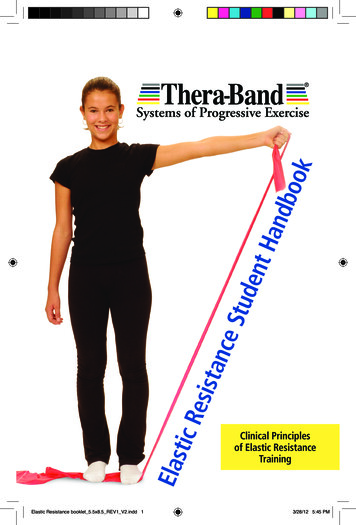
Transcription
StudentHandbookElastic ResistanceClinical Principlesof Elastic ResistanceTrainingElastic Resistance booklet 5.5x8.5 REV1 V2.indd 13/28/12 5:45 PM
Let’s begin by classifying elastic resistance as a unique mode ofresistance. There are 3 traditional modes of resistance training:Isometric, Isotonic, and Isokinetic. Elastic resistance has uniqueproperties compared to the 3 traditional modes, in that the resistanceincreases as the band is stretched; therefore, elastic resistance should beconsidered its own mode of resistance training. Both bands and tubingexhibit similar properties.One of the first questions you may ask is, “How much resistancedo the bands produce?” In order to answer that question, we’ll needto review some basic biomechanics of resistance training, in particulardifferentiating ‘force’ and ‘torque.’FORCE: This is basically ‘resistance.’ With elastic resistance, theforce produced by the band depends on 3 factors: the elastic coefficient(a constant), the amount of elastic material (cross section area), and thepercent change in length, giving us the formula:F k * CSA * LRemember that ‘k’ remains constant; therefore, if you increase thelength or increase the cross-section area (CSA), the force will increaseproportionally. Generally, the different colors of band indicate differentthicknesses (CSA) which increase resistance levels. The percent change inresting length ( L) is calculated by the formula:% L [(Final length – Resting Length)/Resting Length]*100Simply put, if you double the resting length, you have elongated100%; if you take a 1 meter length of band and stretch it to 2 meters,you have elongated 100%.Once you are able to determine how long the band has been stretched,you can use a chart to calculate the force produced based on the Thera-Band color. For example, a 1 meter length of Red band stretched to 100% (doublelength, or 2 meters) gives us about 4 pounds of force. Each progressive steprepresents a consistent pull force increase of 25% in the clinical range (Tanthrough Black) and 40% in the advanced range (Silver through Gold).Color ProgressionResistance in Pounds at:Thera-Band Band/Tubing ColorIncrease from PrecedingColor at 100% Elongation100%Elongation200%ElongationThera-Band Tan-2.43.4Thera-Band Yellow25%3.04.35.5Thera-Band Red25%3.7Thera-Band Green25%4.66.7Thera-Band Blue25%5.88.6Thera-Band Black25%7.310.2Thera-Band Silver40%10.215.3Thera-Band Gold40%14.221.3*Represents typical values. All products not available in all colors.While elastic resistance can increase in force exponentially when stretchedpast 500% elongation, clinical elongations rarely exceed 250%, providing arelatively linear force curve:Force (pounds)The Science of Thera-Band Elastic ResistancePercent Elongation2Elastic Resistance booklet 5.5x8.5 REV1 V2.indd 2-333/28/12 5:45 PM
TORQUE: Clinically, ‘torque’ or ‘moment’ is represented by a ‘strength curve’.It’s important to understand the difference between force and torque. Torqueresults from force applied to a lever arm (LA) around a joint. The ‘strengthcurve’ of elastic resistance can be plotted as a ‘bell-shaped’ curve, meaningthe most torque is produced at mid-range, while the least amount of torque isproduced at the beginning and end of the range of motion.LEVER ARM (LA)FORCE ANGLE (FA)Strength Curve of Thera-Band elastic tubing (Data from Hughes et al. 1999)FORCE (F)This leads us to an interesting question, “Why is the ‘force’ of elastic resistanceascending and linear, while the ‘torque’ is bell-shaped?” The reason is the“force angle,” or angle created by the interaction of the band and the limb.This angle changes throughout the range of motion and changes the ‘effective’resistance; thus the formula for determining the torque of elastic resistance is :The Force Angle (FA) results from the interaction of themoving limb (LA) and elastic resistance force (F)T F * LA * sin(FA)Where torque (T) equals the force (F) multiplied by the length of the limb orlever arm (LA) and the sine of the force angle (FA). This formula demonstrateshow the torque of elastic resistance is minimal at the beginning and end of theROM, while peaking at mid-range.4Elastic Resistance booklet 5.5x8.5 REV1 V2.indd 4-5For example, as shoulder ROM increases from 0 to 180 , the force angledecreases from 180 to 0 . Based on the torque formula mentioned above,the torque at the beginning and end-range is 0 because the sine of the forceangles at 0 and 180 degrees equals 0.53/28/12 5:46 PM
POSITIONING: Most muscles exhibit a “bell-shaped” strength curve,similar to the strength curve of elastic resistance. Based on thebiomechanical principles of elastic resistance, we can improve patientpositioning to ensure muscles are strengthened throughout the range ofmotion. There are 2 basic principles of positioning:1. Use a length of band equal to thelength of the limb moving.This allows us to estimate the percentelongation of the band or tubing to betterpredict the forces. For example if youperform shoulder flexion with a band lengthequal to the arm, the band will elongateabout 100% at 90 and 200% at 180 .You can then find the force produced by theband at a specific angle in the range of motion. Using a length of band equalto the length of the arm (LA) provides 200% elongation over 180 of motion.2. Align the origin with theaxis of rotation so the force angleis minimal at end range.Keeping the origin of the band in-linewith the axis of rotation ensures that theforce angle is minimal at the beginningand end range of motion. If the origin isnot aligned with the axis of rotation, theforce angle will not be minimized at endrange. In addition, keep the resistance within the plane of motion.6Elastic Resistance booklet 5.5x8.5 REV1 V2.indd 6-7EXERCISE DOSAGE: Now that we’ve discussed the biomechanics andpositioning, you’ll need to determine the appropriate exercise dosage: thenumber of repetitions and resistance level. Remember that different colors ofband and tubing indicate different levels of resistance.Following the principles of patient positioning, you can easily estimatethe resistance provided by Thera-Band band or tubing based on the rangeof motion. For example, performing shoulder flexion to 90 with a Red bandequal to the length of the limb moving would produce approximately 4pounds. This is particularly helpful when you have been given resistance limitsafter a surgical repair.POUNDS OF FORCEElongationROMThera-Band ColorThera-Band Exercise Positioning,Dosing & Prescription100%( 90º)200%( 180º)Yellow3.04.3Red3.75.5Green4.66.7Blue5.88.6In general, choose a band or tubing color that allows the individual tocomplete 8 to 12 repetitions per set to the point of fatigue. This is called the“multiple repetition maximum,” or the number of repetitions that can becompleted at one time, no more, no less.73/28/12 5:46 PM
The “Rating of Perceived Exertion” (RPE) scale isBORG SCALE (Borg, 1988)another option for dosing the appropriate intensitylevel. The two most common RPE scales are the6No exertion at all78Extremely lightBorg Scale (Borg, 1998) and OMNI Scale (Robertson,9Very Light2004). Resistance training programs should use a10band color that provides an exertion between 1211and 14 on the BORG scale, or 5-7 on the OMNI scale,while rehabilitation programs may use lower levels.Recently, Dr. Juan Colado of the University of ValenciaLightSomewhat hard1415the next color of band or tubing.On average, there is a 25% increase in resistance between Thera-Band colorsat 100% elongation in the clinical range (Tan through Black) and a 40%NOTES:Hard (heavy)16in Spain validated a new perceived exertion scale17exclusive to Thera-Band resistance products (Colado18et al. 2011). The new Resistance Intensity Scale19Extremely hard20Maximal exertionfor Exercise (RISE) helps individuals indentify theirbecome easier to perform, the resistance can be increased by progressing toincrrease in the advanced range (Silver and Gold).1213The success of an exercise program depends on progression. As the exercisesVery hardexertion from easy to maximal while exercising with Thera-Band resistancebands and tubing. Using the scale helps clinicians prescribe the appropriateintensity and progression of resistance exercise training.8Elastic Resistance booklet 5.5x8.5 REV1 V2.indd 8-993/28/12 5:46 PM
USE AND CARE: There are several important considerations in taking care ofyour band or tubing to be sure they perform properly and last:Muscles and Exercises T Always examine the resistance band or tubing before use for smallnicks, tears, or punctures that may cause the band to break. If youfind any flaws, discard the product and replace before performingany exercises.Store all resistance bands and tubing out of direct sunlight and awayfrom extreme temperatures.After use in chlorinated water, rinse the bands or tubing with tap waterand dry flat.If the bands or tubing become sticky, clean with mild soap and water,dry flat, and then dust with corn starch.SAFETY PRECAUTIONS: There are several safety precautions you shouldfollow when using your bands or tubing: Always instruct the patient or end-user in safety precautions.Latex-sensitive individuals should use Thera-Band latex-free bands.Be aware of exercises that may cause the band to snap back towardthe head, and protect the eyes.Examine the band or tubing for flaws or nicks before using and discardif damaged.Be sure to use a band or tube of appropriate length.Be sure the band or tubing is securely attached to a sturdy objectbefore use.Do not overstretch bands or tubing by 3 times its resting length(200% elongation).10Elastic Resistance booklet 5.5x8.5 REV1 V2.indd 10-11he following chart provides a list of exercises to consider when developingan exercise program. For full exercise descriptions, photos, and customizedhandouts, visit www.thera-bandacademy.com.JointLevel 1Isolated / RehabLevel 2Multi-joint / captionInternal RotationExternal RotationLateral RaiseFront RaiseOverhead PressDiagonal FlexionDiagonal ExtensionArmsElbow CurlElbow ExtensionWrist FlexionWrist ExtensionSupinationPronationUlnar DeviationRadial DeviationKick BackConcentration CurlChestHorizontal AdductionSerratus PressBench PressChest FliesDynamic HugNeckIsometric ExtensionIsometric SidebendingIsometric rotationUpper BackHorizontal AbductionShrugScapular RetractionSeated RowLat Pull DownReverse FliesUpright RowBent Over RowAbs & BackCurl-upTrunk TwistBack ExtensionLower Ab CrunchSide BendLiftChopHipsHip Flexion (standing)Hip Flexion (sitting)Hip ExtensionHip AbductionHip AdductionHip Int RotationHip Ext RotationHip Abd Ext Rot (Clam)DeadliftQuick KicksKneesTKEKnee Extension (Sitting)Knee Extension (Prone)Knee Flexion (Sitting)Knee Flexion (Prone)MinisquatLeg PressSquatLunge1-leg Eversion113/28/12 5:46 PM
Common questionsReferencesElastic vs. Isotonic Resistance TrainingBoth elastic and isotonic resistance exhibit similar strength curves (see page 4).A recent study demonstrated that elastic resistance training is as effective asisotonic weight machines for increasing strength and muscle mass (Colado &Triplett, 2008). Borg, G. Borg’s perceived exertion and pain scales. Human Kinetics:Champaign IL. 1998. Colado J.C., and Triplett N.T. Effects of a short-term resistance program usingelastic bands versus weight machines for sedentary middle-aged women. J.Strength Cond. Res.: 22(5):1441-1448.2008. Hughes, C.J., K. Hurd, A. Jones, and S. Sprigle. Resistance properties ofThera-Band tubing during shoulder abduction exercise. J. Orthop. Sports.Phys. Ther. 29(7):413-420. 1999. Hughes, C., P. Page, and D. Maurice. Elastic exercise training. Orthop. Phys.Ther. Clin. North Amer. 9(4):581-595. 2000. Manor B., Topp R., Page P. Validity and Reliability of Measurements of ElbowFlexion Strength Obtained from Older Adults Using Elastic Bands. J.GeriatricPhys.Ther. 29(1):16-19.2006. Mikesky A., Topp R., Meyer A., Thompson K. Reliability of ten tests forassessing functional performance and strength in older adults. (Abstract).Med. Sci. Sports Exerc. 28(5):S11. 1996. Page, P., and T. Ellenbecker (eds). The Scientific and Clinical Application ofElastic Resistance. Human Kinetics: Champaign, IL. 2003. Page P., M. McNeil, A. Labbe. Torque characteristics of two types of resistiveexercise. (Abstract).Phys. Ther. 80(5): S69. 2000. Robertson R. J. Perceived exertion for practitioners. Human Kinetics:Champaign IL. 2004.Latex vs. Latex-Free BandsA latex allergy is characterized by a reaction to certain proteins found in naturalrubber latex ranging from sneezing to anaphylaxis (a potentially life-threateningcondition). Patients should always be asked about potential latex allergies priorto using elastic resistance bands and tubing. Latex Free Thera-Band resistancebands provide the same quality and trusted resistance progression of Thera-Bandlatex bands.Powder vs. No PowderAll natural latex products require some sort of coating to counteract the naturalstickiness of the latex, using either a powder or a sealant. Thera-Band latexbands utilize a food-grade, non-toxic powder that reduces the natural stickinessof the latex.“Fillers”In addition to latex, ingredients in resistance bands and tubing assist in curing,providing product color, and optimizing the performance of these naturalmaterials. “Fillers” are also sometimes added to latex bands to reduce theirmanufacturing cost; however, this can introduce weaknesses that can leadto tearing and breaking. To provide professional-grade quality, Thera-Bandresistance bands do not contain fillers.For more answers to frequently-asked questions, visitwww.Thera-BandAcademy.com12Elastic Resistance booklet 5.5x8.5 REV1 V2.indd 12-13133/28/12 5:46 PM
It’s important to remember that all elastic bands aren’t“Thera-Band” brand. Be sure the bands and tubing youuse are Authentic Thera-Band brand because:1. Thera-Band’s “Trusted Progression” means thatyou have a clinically proven system of progressiveexercise that you can count on for consistency andquality.2. No other brand has more published research studiesthan Thera-Band elastic resistance.3. The website www.thera-bandacademy.com addsvalue to the brand by providing free access toresearch, exercises, and articles.The Hygenic Corporation.1245 Home Avenue, Akron, Ohio cademy.comTHERA-BAND , the Color Pyramid , and the Associated Colors are trademarks owned byThe Hygenic Corporation or its affiliates and may be registered in the United States and other countries.All rights reserved. 2012 The Hygenic Corporation.HPN #22137 REV 1Elastic Resistance booklet 5.5x8.5 REV1 V2.indd 143/28/12 5:46 PM
Be aware of exercises that may cause the band to snap back toward the head, and protect the eyes. Examine the band or tubing for flaws or nicks before using and discard if damaged. Be sure to use a band or tube of appropriate length. Be sure the band or tubing is securely attached to a sturdy object before use.
